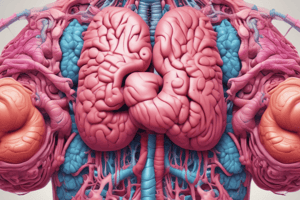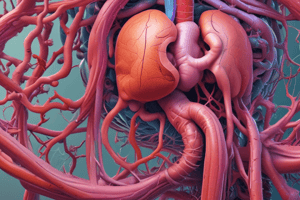Podcast
Questions and Answers
What is the main function of the stomach in the digestive system?
What is the main function of the stomach in the digestive system?
- Absorption of nutrients
- Secreting insulin
- Production of bile
- Breaking down proteins (correct)
Which part of the gastrointestinal tract is responsible for the absorption of most nutrients?
Which part of the gastrointestinal tract is responsible for the absorption of most nutrients?
- Small Intestine (correct)
- Large Intestine
- Esophagus
- Stomach
What is the function of the esophagus in the digestive system?
What is the function of the esophagus in the digestive system?
- Breaks down proteins
- Connects the throat to the stomach (correct)
- Starts the process of digestion
- Absorbs nutrients
Which organ secretes hydrochloric acid and pepsin in the digestive system?
Which organ secretes hydrochloric acid and pepsin in the digestive system?
What is the role of peristalsis in the esophagus?
What is the role of peristalsis in the esophagus?
Which part of the small intestine is responsible for receiving partially-digested food from the stomach?
Which part of the small intestine is responsible for receiving partially-digested food from the stomach?
Which organ is responsible for absorbing water and salt from the remaining food matter after it passes through the small intestine?
Which organ is responsible for absorbing water and salt from the remaining food matter after it passes through the small intestine?
Where is the ileum located in the digestive system?
Where is the ileum located in the digestive system?
Which organ is located under the right ribs just beneath the right lung?
Which organ is located under the right ribs just beneath the right lung?
What is the function of the pancreas in digestion?
What is the function of the pancreas in digestion?
Where does waste matter go after passing through the colon?
Where does waste matter go after passing through the colon?
Which organ is responsible for breaking down alcohol, drugs, and toxic wastes in the blood?
Which organ is responsible for breaking down alcohol, drugs, and toxic wastes in the blood?
Flashcards are hidden until you start studying
Study Notes
Gastrointestinal System Anatomy
The gastrointestinal (GI) system, also known as the digestive system, is responsible for the ingestion, digestion, absorption, and excretion of food. It comprises the GI tract and accessory organs, forming a complex network of organs and tissues that work together to process food and maintain the body's nutritional needs.
Esophagus
The esophagus is a muscular tube that connects the throat to the stomach. It lies behind the trachea and in front of the spine. When you swallow, food and liquids travel through the inside of the esophagus to reach the stomach. The esophagus is lined with a mucous membrane and has a series of muscles that contract together in a process called peristalsis, pushing food down into the stomach.
Stomach
The stomach is a sac-like organ located in the upper part of the abdomen. It starts the process of digestion by secreting gastric juice, which mixes with food and then is emptied into the first part of the small intestine. The stomach contains a third muscular layer, the inner oblique, which assists in churning the stomach contents. The stomach also produces hydrochloric acid and pepsin to break down proteins.
Small Intestine
The small intestine is the longest section of the GI tract and takes up much of the abdomen. It is broken down into three parts: the duodenum, jejunum, and ileum. The small intestine continues the process of digestion, breaking down the food from the stomach and absorbs most of the nutrients. The end of the small intestine (ileum) empties into the large intestine.
Large Intestine
The large intestine, also known as the colon, is made up of the ascending colon, transverse colon, descending colon, and sigmoid colon. It is responsible for absorbing water and salt from the remaining food matter after it goes through the small intestine. The waste matter that is left after going through the colon goes into the rectum, where it is stored until it passes through the anus.
Liver
The liver is a large, complex organ located under the right ribs just beneath the right lung. It performs many important functions, such as aiding in digestion, blood clotting, and breaking down alcohol, drugs, and toxic wastes in the blood, which then pass from the body through urine and stool.
Pancreas
The pancreas is an organ located behind the stomach. Most of the pancreas is made up of exocrine cells which make pancreatic enzymes that help digest foods, especially fats. The rest of the pancreas is made up of endocrine cells which make important hormones like insulin and glucagon, which help regulate blood sugar levels.
Gallbladder
The gallbladder is a small, pear-shaped organ under the liver behind the right lower ribs. It stores bile, a fluid produced by the liver, until it is needed to digest food. The gallbladder contracts to release bile into the small intestine.
Studying That Suits You
Use AI to generate personalized quizzes and flashcards to suit your learning preferences.




